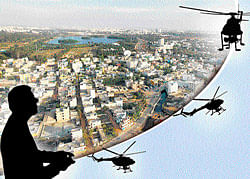
Caught in a mile-long traffic jam, the ambulance driver frantically looks out for a constable. Finding none, he glances at the bleeding accident victim, and dials 103.
A remote-controlled helicopter takes off from a building closeby, flies straight to the traffic-choked road and an onboard camera transmits visuals of the chaos to the control room, live. Minutes later, the source of disruption is identified, removed, the traffic eased, and an alternative route found for quick ambulance passage.
This might look straight out of a Hollywood action flick. Not, if a Bangalore-based outfit, Helicam India, gets its fleet of micro helicopters hovering above the City’s streets and lets the traffic police control the maddening mess. If the police actually adopt this technology, already available in the City, CCTVs could suddenly look outdated!
But these helicopters could do much more than traffic management. Flying to a height of up to 750 ft, these remote-controlled machines could grab pictures of a collapsed building, zoom into a victim crying for help, roll, tilt, pan and dance to a photographer’s tunes. They could capture huge swathes of urban areas in one tight video, rival Google Earth’s panoramic magnificence, aid filmmakers with dramatic aerial visuals or just hang in there snooping around. For Adarsh Bond, the brains behind Helicam India, the fascination with remote helicopter-aided aerial photography had begun four years ago.
Today, his fleet boasts of octocopters, with eight motors, hexacopters with six and quad copters with four motors.
“The more the motors, the more weight these machines can carry. It also depends on the length of the blades, which can go up to a metre. The bigger the blade, bigger the motor and heavier the copter. It could weigh 10 to 12 kg,” he explains.
The octocopter is powerful enough to even carry a Canon 5D SLR camera or a Red Epic, a super professional camera preferred by filmmakers. Adarsh’s efforts were captured in celluloid in the 2011 Bollywood film “Bodyguard.” In the movie, actor Kareena Kapoor is shown being chased by an explosive-laden toy helicopter, controlled remotely by the villain Aditya Pancholi.
Real helicopters could also be prohibitively expensive in filming aerial shots. At a fraction of the price, remote-controlled helicopters could get real close to buildings and take photographs and videos from a hundred angles. “Real helicopters are not allowed to fly below 1,500 ft in urban areas. From such heights, it is impossible to get the shot you are looking for. The helicam can operate in places where a real one cannot access safely,” notes Adarsh.
A French television crew had opted for his hexacopter to film an aerial documentary on Mumbai. The video captured the dynamic verve of the Ganapathi Visarjan from an expansive, bird’s eye viewpoint.
So, how does the job begin? The camera is first mounted onto a platform specially created under the helicopter. Adarsh then takes over the helicopter controls, as the machine gains height. A partner manages the camera movements on a screen, and clicks away once the right angle is achieved.
“You can take the copter only as far as your eye can see. But totally autonomous copters such as the ones used by the military are not restricted to this ‘line-of-sight flying,” he explains.
A GPS-oriented controller ensures that the air-borne copter is locked at a particular position.
“It will stop wherever I want, and not move forward or back. This avoids camera shakes and stabilises the images and videos,” Adarsh explains. He prefers to keep those images sharp that way, as he awaits the election season to unfold with rallies galore. Capturing those politically charged seas of humanity might just be his next aerial venture.